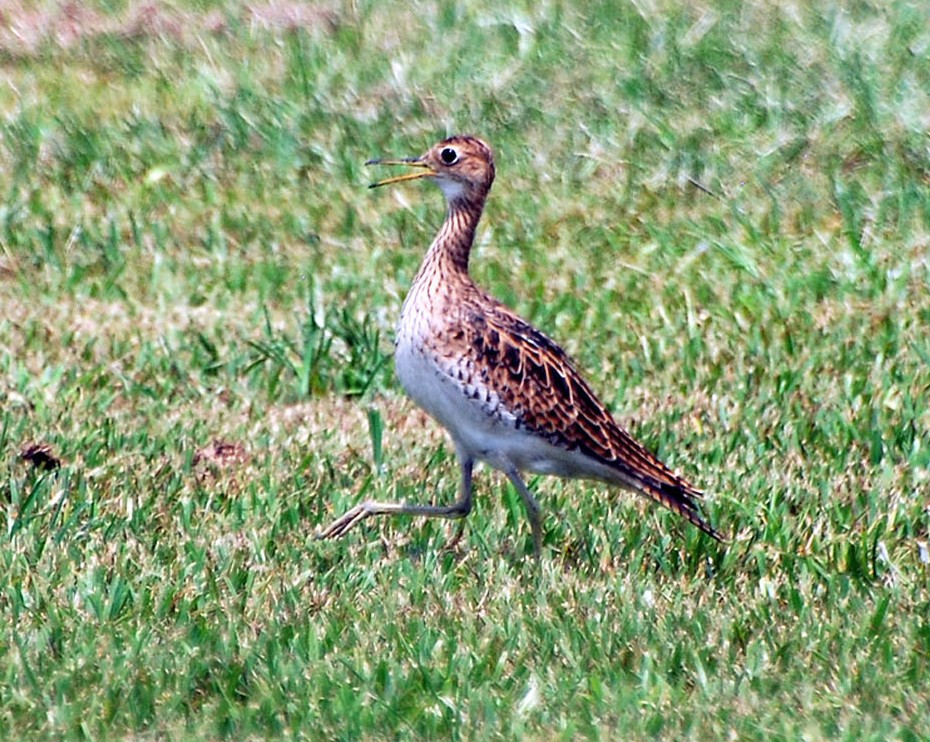Upland Sandpiper
A species of Upland Sandpipers, Also known as Upland Plover Scientific name : Bartramia longicauda Genus : Upland Sandpipers
Upland Sandpiper, A species of Upland Sandpipers
Also known as:
Upland Plover
Botanical name: Bartramia longicauda
Genus: Upland Sandpipers
Content
Description General Info
 Photo By Don Faulkner , used under CC-BY-SA-2.0 /Cropped and compressed from original
Photo By Don Faulkner , used under CC-BY-SA-2.0 /Cropped and compressed from original Description
An adult is roughly 30 cm (12 in) long with a 66 cm (26 in) wingspan. The average weight is 170 g (6 oz). This odd bird has a small dove-like head on a long neck. It is heavily marbled black and brown on the back and wings. The neck is streaked with dark brown which continues down to the breast and on to the flanks. The belly and undertail coverts are white. The tail is quite long for a sandpiper. The upland also sports a white eye-ring and long yellow legs. 
Size
28-33 cm (11-13 in)
Life Expectancy
5-8.92 years
Nest Placement
Ground
Clutch Size
2 - 7 eggs
Feeding Habits
Upland Sandpiper's diet comprises primarily invertebrates, including grasshoppers, crickets, various beetles and larvae, moths, ants, and bugs. They also consume centipedes, snails, spiders, ticks, and earthworms. For plant-based nutrition, upland Sandpiper eats seeds of grasses, weeds, forbs, and occasional berries, wheat, and rye. Their foraging behavior involves picking food from the ground or vegetation while walking, and they are known to flock to recently burned fields or plowed farmlands for abundant prey like grasshoppers and grubs.
Habitat
Upland Sandpiper primarily thrives in expansive grasslands, favoring native prairies of the Great Plains with minimal woody plants and ample bare ground. Their breeding grounds range from various grasslands including pastures and agricultural fields to alpine tundra and mountain meadows in higher latitudes. During migration and winter, they inhabit open areas such as airfields and South American pampas, adapting to altered landscapes like Andean grasslands.
Nest Behavior
Males initiate nest preparation; females complete it while laying eggs. Both parents partake in rearing the young.
Nest Characteristics
Upland Sandpiper nests are ground scrapes lined with grasses, leaves, and twigs, measuring about 4.5 inches across and 1.7 inches deep, often hidden by overhanging grass.
Dite type
Insectivorous
General Info
Feeding Habits
Bird food type
Behavior
Upland Sandpiper demonstrate notable behaviors, particularly during breeding season. They engage in visually striking aerial displays, where both sexes may participate in soaring maneuvers, concluding with a synchronized plummet. Remarkably tolerant during nesting, upland Sandpiper can form loose clusters, with territories intermingling. Post-hatch group dynamics emerge early, as upland Sandpiper assemble in flocks, sometimes even before their chicks are fully independent. Adult upland Sandpiper share incubation duties, though chick-rearing habits require further study. While generally monogamous, complex mating behaviors, such as shared nests and mixed paternity, have been observed. Their daily life intertwines social foraging and resting in groups within their prairie habitats.
Species Status
The numbers of these birds increased as forests were cleared in the early 19th century, but declined sharply in the late 19th century due to hunting. They are now regularly present in Midwestern North America but populations are scattered in the east. Loss of prairie habitat is a concern. Also, livestock grazing has been found to reduce the number of nests in a field. Controlled burns may benefit this species as they feed on low-growing plants that are more easily spotted after a fire. 
Scientific Classification
Phylum
Chordates Class
Birds Order
Shorebirds Family
Sandpipers Genus
Upland Sandpipers Species
Upland Sandpiper